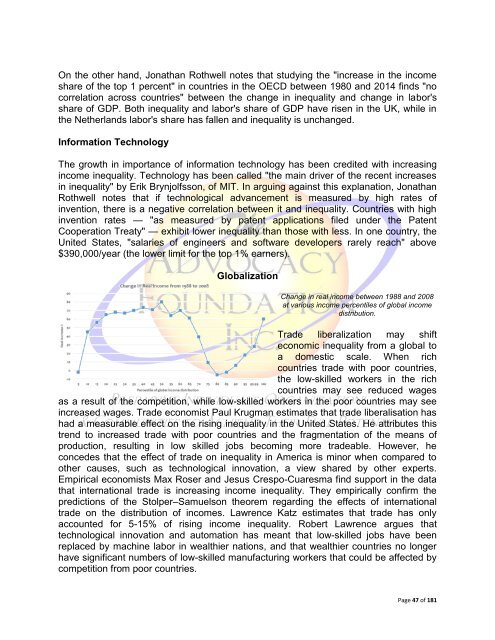Create successful ePaper yourself
Turn your PDF publications into a flip-book with our unique Google optimized e-Paper software.
On the other hand, Jonathan Rothwell notes that studying the "increase in the income<br />
share of the top 1 percent" in countries in the OECD between 1980 and 2014 finds "no<br />
correlation across countries" between the change in inequality and change in labor's<br />
share of GDP. Both inequality and labor's share of GDP have risen in the UK, while in<br />
the Netherlands labor's share has fallen and inequality is unchanged.<br />
Information Technology<br />
The growth in importance of information technology has been credited with increasing<br />
income inequality. Technology has been called "the main driver of the recent increases<br />
in inequality" by Erik Brynjolfsson, of MIT. In arguing against this explanation, Jonathan<br />
Rothwell notes that if technological advancement is measured by high rates of<br />
invention, there is a negative correlation between it and inequality. Countries with high<br />
invention rates — "as measured by patent applications filed under the Patent<br />
Cooperation Treaty" — exhibit lower inequality than those with less. In one country, the<br />
United States, "salaries of engineers and software developers rarely reach" above<br />
$390,000/year (the lower limit for the top 1% earners).<br />
Globalization<br />
Change in real income between 1988 and 2008<br />
at various income percentiles of global income<br />
distribution.<br />
Trade liberalization may shift<br />
economic inequality from a global to<br />
a domestic scale. When rich<br />
countries trade with poor countries,<br />
the low-skilled workers in the rich<br />
countries may see reduced wages<br />
as a result of the competition, while low-skilled workers in the poor countries may see<br />
increased wages. Trade economist Paul Krugman estimates that trade liberalisation has<br />
had a measurable effect on the rising inequality in the United States. He attributes this<br />
trend to increased trade with poor countries and the fragmentation of the means of<br />
production, resulting in low skilled jobs becoming more tradeable. However, he<br />
concedes that the effect of trade on inequality in America is minor when compared to<br />
other causes, such as technological innovation, a view shared by other experts.<br />
Empirical economists Max Roser and Jesus Crespo-Cuaresma find support in the data<br />
that international trade is increasing income inequality. They empirically confirm the<br />
predictions of the Stolper–Samuelson theorem regarding the effects of international<br />
trade on the distribution of incomes. Lawrence Katz estimates that trade has only<br />
accounted for 5-15% of rising income inequality. Robert Lawrence argues that<br />
technological innovation and automation has meant that low-skilled jobs have been<br />
replaced by machine labor in wealthier nations, and that wealthier countries no longer<br />
have significant numbers of low-skilled manufacturing workers that could be affected by<br />
competition from poor countries.<br />
Page 47 of 181

















